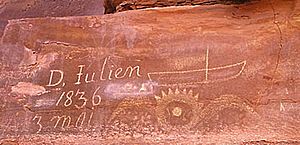Denis Julien facts for kids
Denis Julien (born around 1772) was a fur trapper and trader of French-Canadian background. He was active in the southwestern United States in the 1830s and 1840s. At that time, he was one of the few people of European descent in the area. He is mainly remembered for carving his name and dates on rock faces in Utah and Colorado during his travels. At least eight of these carvings are known to be his. Four of them are listed on the National Register of Historic Places, which means they are important historical sites.
Contents
Early Life and Travels
We don't know exactly when or where Denis Julien was born. He seems to have lived in St. Louis in the 1790s. The first records mentioning him are from 1793. They show he had children with his Native American wife, Catherine.
Julien started working with a major fur trader named Jean-Pierre Chouteau in Saint Louis. This job kept him busy as a trader and trapper across the Midwest. His name appears in Chouteau's business records as early as 1803. He owned land in what is now Iowa and Wisconsin between 1805 and 1821.
In 1808, Meriwether Lewis, who was the governor of the Louisiana Territory, wrote about Julien. He called him an "old and respected trader among the Ioways." Julien also received licenses to trade on the upper Missouri River in 1816 and 1817. He stayed connected to important fur trading families in Saint Louis during this time.
Journey to the West
In 1827, Julien made his first trip to the American Old West. He was part of a group trying to find hidden furs. They traveled through Taos, New Mexico, and reached the land of the Ute people in what is now southern Utah and western Colorado.
A Ute chief's son, Nauhnan, spoke of a trading post set up by "white man the Indians called 'Sambo' and the other one called 'Julie'." People believe "Julie" referred to Denis Julien. In 1828, Julien and others set up the Reed trading post near Whiterocks, Utah. They brought new items like butcher knives and coffee beans to the area. They traded these goods with local Native Americans for furs. This trading post did not last long. It was sold in 1832 to Antoine Robidoux, who built Fort Robidoux nearby.
Rock Inscriptions
Julien stayed at Fort Robidoux until 1836. The rock carvings he made during and after this time are the only records of his movements later in life. These carvings are very important.
First Marks in Utah
The earliest known Julien carving is on the Uinta River. He scratched his name and the date, "Denis Julien 1831," on a sandstone ledge. By doing this, he became one of the first Europeans to leave a dated mark in what is now Utah. Only a 1776 carving by the Domínguez–Escalante expedition and an 1825 carving by William Henry Ashley are older.
Julien left dated marks in 1831, 1832, 1836, 1838, and 1844. He seemed to travel along the Colorado and Green rivers in a boat. One of his carvings even shows a boat with a mast!
Where to Find His Carvings
Of the eight carvings generally accepted as real Julien inscriptions, seven are in Utah. One is just across the state line in Colorado. Two of these eight have been lost over time, but they were reliably reported. There are also two other carvings in Utah that some historians think might be his, but it's not certain. Many of Julien's carvings were not found again for more than a century after he made them.
All of Julien's genuine carvings show his full name or initials and the date. He used French spellings. His carvings are usually found on flat parts of large rocks or canyon walls. They are very close to the water level of rivers. You can tell his carvings by their deep, bold cuts into the rock. He often used old-style French block letters. For example, his capital "J" often looks like a modern capital "I" or "E." His carvings are often next to much older petroglyphs made by prehistoric people. You might also see later carvings from cowboys, prospectors, and tourists nearby.

Four of Julien's carvings are listed on the U.S. National Register of Historic Places:
- Hell Roaring Canyon inscription: This carving is dated May 3, 1836. It is on a square rock face above the Green River in southwestern Grand County, Utah. It is near the mouth of Hell Roaring Canyon.
- Lower Red Lake Canyon inscription: This one is dated 1836. It is near the top of a slope on the east bank of the Colorado River. It is just below the mouth of Lower Red Lake Canyon in Canyonlands National Park, San Juan County, Utah. Some historians question if this one is truly his.
- Whirlpool Canyon inscription: Dated 1838. This carving is in a small cave on the Green River. It is a few miles downstream of Echo Park in Dinosaur National Monument, Moffat County, Colorado.
- Julien Inscription Panel: This carving is dated June 9, 1844. It is at the base of a large sandstone rock formation. It is at least 15 miles inland from the nearest river. You can find it in the Devils Garden area of Arches National Park, Grand County, Utah. The authenticity of this one is also debated.
Another Denis Julien carving from 1836 was found in lower Cataract Canyon in 1964. However, it is now covered by the water behind Glen Canyon Dam. There is also an undated "DJ" carving at the mouth of Chandler Creek in Desolation Canyon on the Upper Green River. It is on a large rock near the road at the bottom of the canyon.

